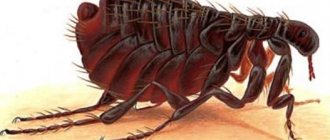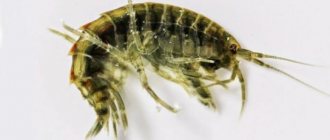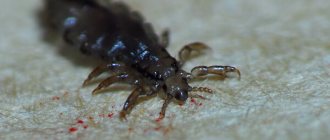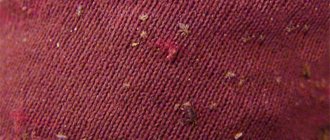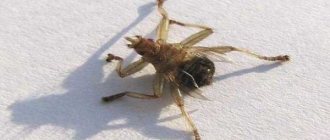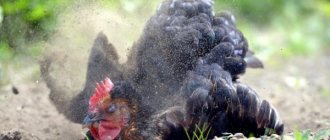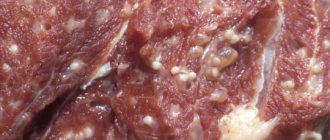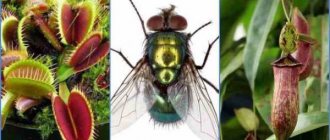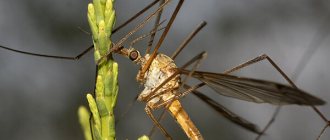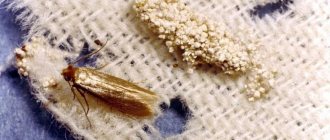Fleas have been “accompanying” human life since the very time when he had his first pet. Typically, these blood-sucking insects parasitize our pets - cats and dogs, and therefore we inevitably encounter them.
Although they adapt to specific animals, when there is a shortage of food, human blood is quite suitable for parasites. Therefore, our article is about what the insect is and how it spreads, what harm it causes to humans, and whether it is possible to get rid of fleas once and for all.
Appearance of a flea
These are small insects, so it is not always possible to notice them right away. Flea bites are painful, and the site of the bite is “marked” by a pink spot. The body of a flea is on average from 1 to 5 mm, but a well-fed insect has a stretched abdomen, due to which the size increases to 1 cm. The fertilized female reaches a large size - up to 1.5 cm. The body is divided into a head and abdomen, protected by a chitinous shell.
Under a microscope, a flea resembles a shrimp. This is the most convenient body shape, as it helps to move faster through fur or feathers and hide in secluded places. Three pairs of strong limbs allow her to move by jumping. The limbs have claws so that they can cling to fur or any surface.
This is interesting: The lifespan of the parasite ranges from several months to 3 years. How long an insect lives depends on the ambient temperature. High temperatures shorten life expectancy, low temperatures prolong it, since in cool conditions the life cycle proceeds slowly.
The eyes are located on the head, above which are antennae. They are needed so that the male can hold the female during mating. The rest of the time they do not play any role. The spines and bristles covering the skin are a kind of protection, making it almost impossible to comb out a flea.
The color of the parasite varies from yellowish to brown and black. The piercing-sucking mouthparts are designed for feeding. The stylet at the base helps to bite through the host's skin, increasing the size at the site of the bite. The flea injects saliva into the wound to prevent the blood from clotting. She penetrates there with her whole body in search of a blood vessel. The parasite becomes completely saturated in one bite, increasing in size.
This is interesting: Fleas have a special sensory organ - the pygidium, located on the abdomen, in its rear part. The pygidium is covered with hairs that are sensitive and react to any air vibrations, giving a warning signal of danger.
Instructions for action
You can get rid of insects in your apartment using various drugs that are freely available today. These are “Raptor” and “Raid”, “Combat” and a number of analogues. Read the instructions carefully before use. All things, floors and walls, furniture will have to be processed. Follow a few simple guidelines. Before treatment, be sure to vacuum the entire apartment. Throw away all trash at once, as insect larvae may remain in the dust. Just in case, treat the apartment or house twice. If fleas have settled in a person’s hair, be sure to treat it with a special shampoo.
Types of fleas and their danger to humans
We will only talk about those types of fleas that live in our homes. These are cat, dog and human fleas. What is their difference?
- Cat flea: The most common flea in the flea kingdom. On an animal it looks like small lumps of dirt. Dark discharge (excrement) also remains on the fur. The female lays eggs, resembling white grains, in cracks in floors, in the upholstery of upholstered furniture, and under carpets. It differs from the rest in its flat body and tiny head. Are cat fleas dangerous for humans? They feed on his blood when the main owner is not nearby.
- Dog flea: parasitizes dogs, cats, and horses. The body is slightly flattened on the sides. It does not often visit humans, but in severe hunger it will not disdain human blood. She jumps quite far: three times further than she sees. The bristles allow them to adhere well to the owner's fur.
- Human flea: Most often feeds on a person, especially if he has a characteristic odor and the hair is rich enough. Fleas can stay on humans for only a short time, moving onto cats or dogs. Signs of an “attack” are the presence of small wounds that itch very much. You can also notice a small dark dot on the body; this is an attached parasite that happily absorbs blood.
Note: A flea lives without food for 1-3 months. In this case, the insect does not fall into suspended animation, but simply becomes less active and does not reproduce. When favorable conditions arise, the parasite comes to life and begins to feed on those warm-blooded animals that are nearby.
Are fleas dangerous for humans? A bite is not always dangerous, only in some cases it leads to dire consequences. The real threat is that by biting another animal, and then a person, the flea is capable of transmitting infections, infecting all its potential victims.
Individual characteristics
Of course, each person will have their own reaction. There are people who are completely insensitive. They simply won't notice the bite and will claim that the fleas didn't bite them. Other family members who do not have this property of the body may notice slight discomfort. Allergy sufferers have it worst of all. On their body, each bite will turn into a huge bubble that will itch and hurt. Antihistamines will help improve the condition a little, but the problem will not go away completely.
Signs of a parasite
Do fleas live on people? Permanently - no, parasites live on the fur of pets for a long time. They visit a person to have a hearty and satisfying meal, and then they can move onto a cat or into the carpet pile. These are not lice that live on the body permanently. Fleas live on humans only while they feed. Therefore, the question: are fleas transmitted from cats to humans is itself formulated incorrectly. There is no talk of any transfer from one owner to another.
Article on the topic: What is the difference between fleas and lice
Vampire fleas only quench their thirst, after which the female can hide in a secluded, dark and damp place to lay eggs. Males can live in animal bedding or garbage. Therefore, contaminated bedding, basements, and garbage cans can be a source of danger from which an attack will occur.
All secluded corners where annoying blood-sucking creatures hide are located close to warm-blooded animals and humans. They remain invisible and disappear after a bite. How fleas bite has been described before. If the skin is sensitive, the bite may be painful and small reddish spots may appear on the body. Fleas will attack constantly, so you need to know where they live:
- in the cracks of the floor between the boards,
- under the baseboard or threshold,
- in the pile of carpets and upholstered furniture,
- in linen and bedspreads, especially fluffy ones,
- in storerooms and basements,
- in the bedding of domestic animals.
Here they can reproduce, lay eggs and attack their potential victims.
Note: The development cycle of the parasite ranges from 2 weeks to a month, depending on living conditions. A larva emerges from the cocoon and searches for a host. If this happens en masse, large colonies develop. Up to 200 individuals can “live” in the fur of one animal at the same time.
Transfer methods
There are many myths around these insects. Animal lovers are still arguing among themselves whether cat fleas can spread to humans. Contrary to popular belief, these parasites are not transmitted to humans from animals. But from the latter they settle on bedding, in the cracks of the wooden floor, and from there they attack the owner of the house. And even if there are no pets at home, this does not mean that a person will not be attacked by parasites. They make their way into the apartment through basements, attics or through rodents. Fleas thrive in crevices and secluded places. That is, wherever it is warm and humid. For insects, warm-blooded animals are important not only as a source of fresh blood, but also as transport. They transport bloodsuckers from place to place.
How dangerous are fleas to humans?
The bite is sensitive because an enzyme gets into the wound with the little vampire’s saliva, thanks to which the blood does not clot. Therefore, the flea can get plenty of food. A small pink spot remains at the site of the bite, which causes severe itching.
Most often, bites are clearly visible on the legs. They are located scattered, in the form of small pink dots a few centimeters from each other. Flea bites are also noticeable on other parts of the body: most often on the arms, neck and armpits. If flea bites are actually present on a person, then there is tar soap and flea shampoo intended for people. If you find pink sores on your child's body, you should consult a doctor.
Depending on the individual characteristics, various lesions occur on the skin:
- allergies of varying severity,
- tumors at the site of the bite,
- swelling occurs and internal hemorrhages are possible,
- wounds become infected and ulcers form,
- dermatitis develops.
Before fleas bite people, they can parasitize other animals, transmitting infection and becoming pathogens of diseases: plague, typhoid, tularemia, salmonellosis, hepatitis B and C. They can also transmit helminth eggs, which leads to the development of parasites inside the body .
Important! Fleas are temporary parasites that can jump from one place to another, picking up an object to feed on. They develop best at t=+18-27C and humidity 70-100%. In 20-50 days, under favorable conditions, the flea turns into an adult. At low humidity the larva dies.
Treatment of bites
To relieve pain and itching, the bite sites are wiped with a cotton swab soaked in boric or ethyl alcohol. The skin can be pre-washed with soapy water. To reduce swelling, apply an ice cube.
All fleas on the human body are removed mechanically: this can be done in the shower with a stream of water, and combed out of the hair with a fine comb.
Antihistamines are used to relieve the symptoms of an allergic reaction.
As an additional therapy, you can use traditional methods: make a compress with a decoction of mint and bird cherry, apply lemon peels or drunk tea.
If, in addition to skin manifestations, there is an increase in temperature, purulent inflammation and enlarged lymph nodes, you need to consult a doctor.
Additional examination may also be required to prevent the development of complications and concomitant diseases carried by parasites.
How to get rid of fleas and is it possible to destroy them?
It is impossible to protect yourself from bites; you should clear your pets and home of “uninvited guests.” The first place to start is to check your cats and dogs for fleas. They may not be visible, but insect excrement is clearly visible on the fur. They come out of wool very well. You just need to purchase special sprays or gels, shampoos, and flea collars from pet stores. After treating with the spray, you should put on a collar so that your pet does not become infected again. The collar will protect against re-infestation of fleas.
Since the “bloodsuckers” also live in the room itself, it will have to be disinfected. Fleecy fabrics need to be treated especially carefully: carpets, rugs, bedspreads. It is better to destroy the bedding on which pets slept. You should pay attention to any cracks, baseboards, or holes in the walls where annoying insects may be hiding. First, you should thoroughly vacuum the house, and then start staining.
Important! Heating appliances should be turned off, pets should be removed, food should be carefully packed, and it is advisable for apartment owners to leave the house for a couple of days, since most flea remedies are toxic. The treatment must be repeated after 2 weeks, since the larval stage of the flea is quite long.
Prevention
Prevention includes comprehensive measures that create unacceptable living conditions for parasites. Clean the apartment of dust, throw out trash, get rid of old furniture and carpets, and avoid dampness.
For pets, purchase parasite-repellent collars and use insecticidal shampoos for bathing. Regularly shake out animal bedding, clean the cages of birds and rodents.
Once a week, wash the floors in your house by adding a decoction of wormwood or geranium essential oil to the water. Under the carpets, in the ventilation hole, place sprigs of mint, rosemary, and lavender. Fleas hate strong odors, so they will avoid the apartment.
Remedies for fleas in humans
The choice of products for home treatment is relatively small due to the food specialization of insects. They will not eat poisoned bait; their food is blood. If fleas have settled in a person’s apartment, they are destroyed using two substances that have different effects:
- Sprays and aerosols that penetrate the parasite's body with air. Due to the quick action, getting rid of fleas will not be difficult.
- Powders and suspensions that penetrate the chitinous integument of an insect. They do not act so quickly, they act thoroughly, destroying all parasites.
The most popular flea spray is Raptor. Also used for disinfection are Solfak, Chlorpyrimark, Tetrix, and Efficient Ultra. After treatment, the apartment should be thoroughly rinsed to destroy any remaining toxic drugs. There is no need to use any poisonous substances that come into your hands. This will not only not give results, but can also lead to mutation of fleas and in the future it will be even more difficult to remove them.
Effective Ultra
Chlorpyrimark
Raptor
Solfac
Tetrix
A specialized institution can also help, from where they call specialists to treat the premises. You just prepare the apartment and leave it. After treatment, the special service workers will explain how to clean the room from the toxic substance, give guarantees, and, if necessary, carry out re-treatment.
Note: After processing and cleaning the apartment, for the purpose of prevention, we place fresh or dry wormwood with inflorescences in the corners, along the baseboards, under the carpets. Spraying the room with tansy tincture will help. They can not only repel, but also partially destroy insects.
Where to begin
If you discover parasites in your home, act immediately. First of all, do some general cleaning.
- Wash curtains, bed linen, blankets and rugs.
- Wash floors, walls, door frames, windows.
- In the warm season, take pillows, mattresses, carpets outside, beat them out and leave them under the scorching rays of the sun for 2 hours.
- Fleas cannot stand the heat, so they immediately leave their homes. In winter, treat things with a steam cleaner.
Go through the contents of your wardrobes. Get rid of old unnecessary things. Eliminate leaking faucets, seal cracks in baseboards and pipe joints with sealant. Select a high-quality insecticidal preparation and carry out disinfestation.
Handling Precautions
When using chemicals and some folk remedies, certain precautions must be observed:
- Processing should be carried out only using personal protective equipment;
- if the drug gets on the skin, it should be washed off with cold water;
- After treatment, ventilate the room well;
- prevent drugs from getting on clothes and food;
- do not allow strangers to be in the room during processing;
- After the drug has expired, it is necessary to carry out thorough cleaning.
